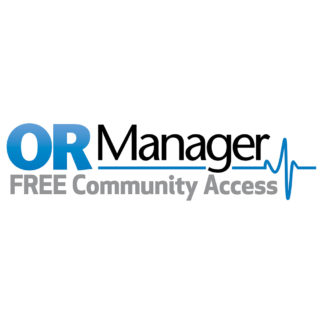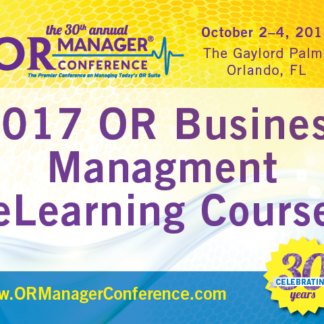Description
This package includes session recordings compiled from Data + Analytics and Technology breakout and general sessions at the 2022 OR Business Management Conference. After viewing the content, complete a brief quiz and evaluation to earn 7 CEs.
Presentations include:
- Mind the Gap: Using Technology to Improve Communication and Manage Change
- Case Duration Predictive Model Implementation
- OR “Black Box” Technology: Implementing an Innovative QI Project to Enhance a Culture of Safety
- Keynote: Powering OR Performance with Data: Northwestern’s Journey, Outcomes, & ROI
- Keynote: Cybersecurity Risk Management – Protecting Your OR and Your Bottom Line
- Keynote: Using Automation to Grow Surgical Volumes, Reduce Workload, & Optimize Referrals
- Keynote: Still Struggling to Optimize OR Utilization? There’s a Better Way!
Learn more about the sessions below:
Mind the Gap: Using Technology to Improve Communication and Manage Change
The Massachusetts General Hospital central sterile processing and supply department launched a strategic initiative to optimize OR supply management. After a comprehensive evaluation of existing supply workflows, senior leadership identified two strategic opportunities to increase OR supply management efficiency: realign role groups to work at the top of their skillsets and redistribute responsibilities across shifts. The most critical component of the resulting operational plan was to move stock replenishment functions from the day shift to the night shift, and in this new model, elevate existing inventory specialists to perform advanced supply management functions on the day shift.
Minimal disruption to the OR, as determined by feedback from perioperative administration, physicians, and nursing, was crucial to successfully transition replenishment activities to the night shift. While planning the transition, the team identified a major potential barrier to success: informal communication channels that would obscure and further silo inventory management work. To increase visibility for leadership, enhance accountability, and support collaboration between the night and day shift staff, the team developed a portfolio of Smartsheet-based tools that are adaptable, user-friendly, and capable of facilitating complex workflows involving multiple teams.
The team mapped existing and future workflows, identified process owners, and designed Smartsheet tools to support inventory management optimization efforts. As a result of deliberate stakeholder engagement, user-testing, training, and staged implementation, the Smartsheet tools have supported the successful transition of stock replenishment to the night shift and greatly improved visibility into the current scope of operational challenges in OR inventory management.
Learning Objectives:
- Describe key contributing factors to successfully launching a portfolio of collaborative tools.
- Identify opportunities to increase visibility into inventory management activities.
- Assess Smartsheet as a tool for achieving operational efficiencies.
Case Duration Predictive Model Implementation
Calculating an accurate duration for scheduling surgical cases can be very complex due to significant variability found between patients, procedures, and surgeons. Northwestern Memorial Hospital (NMH) has made enhancements to the case request workflow and built a custom case duration predictive model to improve our scheduled case duration accuracy. At NMH, case duration accuracy is defined by a case finishing within 15%, or within 10 minutes, of the scheduled case duration. The predictive model is expected to improve our case duration accuracy from 42% to 53% across all service lines, including add-ons.
This predictive model is a gradient boosting tree model that takes the Epic generated duration and modifies it based off many different case specific factors. Some key factors that most impact the case duration (as identified in the model) are patient weight, surgeon requested time, clinical risk factors, procedural regions, and anesthesia type, among others. The predicted duration is not only expected to be more accurate for single procedure cases; for cases with multiple procedures, the predictive model is significantly more accurate than Epic’s average duration calculator. Additionally, it is expected to be more accurate across all service lines and 90% of individual surgeons.
When implemented, the predicted case duration will be built into the case details where our scheduling team will be able to review, utilize, and refresh as necessary. The predicted time will calculate soon after the case is requested, allowing the case to be booked with the appropriate time from the start. The expected impact of the increased accuracy will both reduce our patient delays and unexpected overtime as well as improve surgeons’ ability to schedule the appropriate number of cases in their allocated block. We expect the percentage of cases that run pasts the scheduled duration to reduce from 32% to 24%, and cases that finish ahead of their scheduled duration to reduce from 26% to 23%.
Learning Objectives:
- Describe key takeaways for improving your case duration accuracy utilizing existing Epic functionality.
- Assess the feasibility of creating a custom predictive duration model.
- Identify how to best implement and operationalize a custom predictive model within existing workflows.
OR “Black Box” Technology: Implementing an Innovative QI Project to Enhance a Culture of Safety
Surgical errors resulting in adverse events are significant causes of morbidity and mortality in the US. The majority of surgical adverse events occur in the OR, and as reported in literature, nearly 50% of the adverse events are preventable. The OR is a complex environment, and creating a culture of safety is contingent upon the ability to not only learn from adverse events, but to celebrate behaviors that are congruent with best practices. To actively drive a robust culture of safety, it is imperative for perioperative teams to promote transparency and facilitate learning by incorporating innovative technology.
Consistent with lessons learned in the aviation industry, the implementation of the Surgical Safety Technologies “Black Box” captures continuous, comprehensive intraoperative data and monitoring for targeted interventions to discover effective ways to identify errors and prevent them from recurring. The implementation of the Black Box quality improvement project in a large, tertiary academic medical center has created transparency among surgical teams and facilitated open dialogue to enhance teamwork. The data obtained from this initiative has shown an increase in OR efficiency for first case on time starts; reduction of turnaround times; and increased the quality, engagement, and compliance of the surgical timeout checklist. Supporting an environment of transparency, all members of the OR team are empowered to request a surgical case review using the Black Box technology to learn from defects and identify possible safety concerns, incorporating findings into action items as a proactive approach to promoting a culture of safety in the OR.
Learning Objectives:
- Describe benefits of incorporating Black Box technology to enhance communication among clinical teams in the OR.
- Identify opportunities to integrate innovative technologies to enhance patient safety in the OR.
- Describe key strategies to enhance OR efficiencies using new technologies.
Keynote: Powering OR Performance with Data: Northwestern’s Journey, Outcomes, & ROI
For most hospitals, ORs are the economic engine. It is frustrating for hospital leaders and managers to base very expensive decisions on anecdotal or inaccurate OR utilization information. For example: do you really need to build a new OR? Do you need to add an additional robot? It is also stressful to have difficult conversations with surgeons about block utilization, particularly when the surgeons have options to take their cases elsewhere. The key to OR utilization and performance improvement lies in access to accurate, timely, and transparent data. Unfortunately, this is not the type of data delivered by traditional EHRs.
Join Northwestern’s director of business operations, surgical services, to hear how the health system decided to adopt a cloud-based software solution to gain access to transparent data, defensible metrics, powerful visualizations, and easy-to-use tools “on the fly.” Hear how the adoption has improved data transparency and decision making; filled valuable time during the day that had previously gone unused; and even delivered a solid ROI within a very short timeframe.
Learning Objectives:
- Explain why, even after a significant EHR investment, hospitals still need to invest in data management systems, particularly for the OR.
- Discuss the benefits of adopting a culture of data transparency in perioperative analytics.
- Analyze how Northwestern’s leveraging of predictive and prescriptive analytics tools yielded positive outcomes and ROI.
Keynote: Cybersecurity Risk Management – Protecting Your OR and Your Bottom Line
Each year, ECRI, an independent not-for-profit healthcare research organization, produces its list of 10 health technology hazards that warrant priority attention for the coming year. The list highlights key technology safety topics that the organization’s researchers have determined can occur, can lead to patient harm, and—importantly—can be prevented if appropriate measures are taken. This presentation will discuss the purpose of the list, provide behind-the-scenes details about the topic-selection process, and review the topics included. We will also review selected topics in detail and outline action steps to prevent harm. Join this breakfast session to learn why cybersecurity attacks are ranked as the #1 health technology hazard for 2022!
Learning Objectives:
- Discuss ECRI’s top 10 health technology hazards.
- Identify why the hazards made the list and describe action steps to prevent harm.
- Describe why cybersecurity attacks are ranked as the #1 health technology hazard for 2022.
Keynote: Using Automation to Grow Surgical Volumes, Reduce Workload, & Optimize Referrals
Nearly 30% of OR time is unused. OR time is locked up as a result of inefficient processes and manual tools. Now, staffing shortages are limiting OR access even more. As a perioperative leader, how can you drive growth and maximize investments in spite of these challenges?
In this keynote session, discover how University of Arkansas for Medical Sciences (UAMS) was able to automate OR scheduling processes with AI and machine learning-based software. By unlocking OR time weeks in advance, UAMS increased OR access and improved robotic room utilization, adding millions to the bottom line. By eliminating manual steps and using AI to guide decisions, the organization reduced workload for schedulers and increased satisfaction for surgeons.
Join leaders from UAMS and Qventus to learn about this breakthrough approach proven to deliver immediate value and a sustained advantage.
Learning Objectives:
- Identify how you can add two or more cases per OR per month and grow revenue by $10M+ per facility.
- Describe how automation improves satisfaction for schedulers, surgeons, and OR teams.
- Discuss how automation reduces OR scheduling call volume by over 40%.
Keynote: Still Struggling to Optimize OR Utilization? There’s a Better Way!
The way we manage OR blocks and capacity is broken. Traditional tools require significant manual effort and lack real-time connection to automate provider schedules and PTO, as well as up-to-date patient case information. The use of disparate systems to manage these operations restricts hospitals and health systems from truly optimizing capacity.
QGenda Capacity helps healthcare organizations manage all provider operations in one place and optimize capacity. With this new operational tool, for the first time, hospitals and health systems can easily view and manage real-time provider schedules, OR blocks, and patient case information in a centralized location—increasing efficiency and giving visibility into schedule and patient densities.
With provider schedules, OR blocks, and patient case information in one location, perioperative leaders can improve OR block allocation and utilization, accurately align provider time and resources to patient demand, and ensure more patients receive the care that they need faster. Ultimately, this enables hospitals and health systems to increase patient access, improve revenue capture, and positively impact provider performance and satisfaction.
Learning Objectives:
- Breakdown the challenges associated with OR capacity management as it stands today and why disconnected systems are insufficient for truly improving resource utilization to align with demand.
- Introduce a new operational tool, QGenda Capacity, that brings together real-time provider schedules, OR blocks, and patient case information in one centralized location to streamline workflows and optimize capacity.
- Discuss strategies for optimizing capacity that will enable hospitals and health systems to increase patient access, financial wellbeing, and provider performance.

